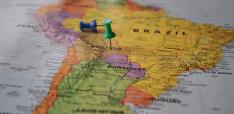GLI at the G7 - The Political Logic of Logos
72
Normal
0
false
false
false
EN-GB
X-NONE
X-NONE
/* Style Definitions */
table.MsoNormalTable
{mso-style-name:"Table Normal";
mso-tstyle-rowband-size:0;
mso-tstyle-colband-size:0;
mso-style-noshow:yes;
mso-style-priority:99;
mso-style-parent:"";
mso-padding-alt:0cm 5.4pt 0cm 5.4pt;
mso-para-margin:0cm;
mso-para-margin-bottom:.0001pt;
mso-pagination:widow-orphan;
font-size:10.0pt;
font-family:"Times",serif;
mso-bidi-font-family:"Times New Roman";}
This year the Global Leadership Initiative at the University of Sheffield have taken a team of policy analysts to the G7 Leaders Summit, Ise-Shima, Japan. This post is part of a series of blogs, opinion pieces and policy briefings from the summit.
Media Centre - G7 Ise-Shima Summit. The last few years have been challenging times for Japanese logo designers. In September last year, the logo for the 2020 Tokyo Olympics had to be withdrawn after allegations of plagiarism surfaced. The replacement was met with a lukewarm reaction but was at least original if uninspiring.
Earlier this month, the new logo of the main opposition party in Japan, the Democratic Party, was met with similar accusations of plagiarism, but the controversy this time was compounded by concerns that the logo, based on a highly stylised letter ‘M’ (the first letter of the Japanese name of the party, Minshinto), resembled a man groping a woman.
This predilection for controversy has extended to the G7 Ise Shima Summit. Shima City, famed for its female pearl divers, decided in 2014 to create a manga-based mascot, named Aoshima Megu, as part of its preparations for the summit. By the end of 2015, met with an online petition and complaints of sexism because of her ‘exaggerated features’ and tendency to bare too much skin, the mascot was divested of its official status.
So far, the official summit song entitled ‘Time’ sung by Hirai Ken, has managed to avoid any similar controversy. The Japanese hosts also arranged an official song for the 2000 Okinawa Summit with the title ‘Never End’, which fortunately for us all did.
One does have to ask why a summit meeting of the world’s richest countries focused on the pressing global challenges of the day needs logos, mascots or songs. According to Mertes, the original function of logos ‘was to offer visual emblems of quality… symbols of a reliable or desirable product’. In the field of global summitry, logos have become a necessity and a shared characteristic of every international organization across time and space from the League of Nations to the UN, IMF, World Bank, EU, ASEAN and so on. In this way, logos have come to symbolise an aspect of professional ‘quality’ further representing an identity marker for the political legitimacy of an ‘established’ global institution. This no doubt underpins the political logic of the G7 hosts, who wish to assure people of the quality, reliance and desirability of these informal groupings through these artefacts of popular culture. So, logos, and by extension mascots and songs, further become a means of securing the buy-in of groups that may feel ambivalent at best towards an organization or summit meeting. This attempt to boost legitimacy and buy-in is best illustrated in the choice of this year’s G7 Ise Shima Summit logo, which was selected via an open competition process between school children in Japan. By opening the logo design to the public, the G7 hosts are providing a subtle suggestion that the summit is in some way ‘your project too’ and not just the meeting ground for the rich and politically powerful.
However, these seemingly ephemeral and trivial aspects of a summit can only go so far. We should heed the words of Shaun McIlrath of the advertising agency Heresy:
A ship does not go faster if you repaint it. And an image change for a company or political party can only be truly effective if it is immediately supported by actions – in both culture and policy – that reflect that new image. The consumer or electorate … needs to identify and experience the changes, not just see a new colour scheme. A redesign may be an indication of change but the proof is in the delivery.
In light of this wisdom, as with the open competition for this year’s logo, G7 leaders would do well for their product to open the substance of global summitry to better forms of political legitimacy. Thus, moving beyond the marketing pitches to build better links to global publics, so that ordinary citizens can begin to feel that global summits such as the G7 is representative of being ‘your project too.’
The GLI team consists of Garrett Wallace Brown, John Casson, Rachel Claringbull, Hugo Dobson, Elliott Glover, John Jacobs, Magdalena Krakau, Gregory Stiles.


